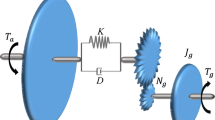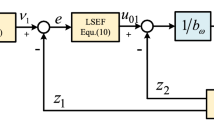Abstract
The wind turbine blades have complex stress states, and the load has the characteristics of time-varying and uncertainty. Aiming at the interference problem caused by complex and variable load characteristics to the individual pitch control system, combined with the variable-pitch load characteristics, based on the permanent magnet synchronous motor (PMSM) vector control strategy and LADRC (Auto Disturbance Rejection Speed Controller), an individual pitch speed controller is designed. Linear expansion state observer is built. The control algorithm is deduced and the relationship between each control parameter is analyzed to improve the anti-interference ability of the system to the abrupt load of the pitch. On this basis, the system position tracking controller is built. Finally, a vector control simulation model was built based on MATLB/Simulink, and a speed control simulation was carried out. The simulation results show that LADRC has a strong anti-load disturbance capability, and has better anti-disturbance resistance than PID speed control, and the position controller based on this has a better position tracking effect. At the same time, the effectiveness of the designed independent pitch speed controller has also been verified through experiments. It is of great significance for improving the conversion efficiency of wind energy.










Similar content being viewed by others
References
Liu W, Ren H (2020) A novel wind turbine health condition monitoring method based on common features distribution adaptation. Int J Energy Res 44(11):8681–8688
Liu WY, Tang BP, Han JG, Lu XN, Hu NN, He ZZ (2015) The structure healthy condition monitoring and fault diagnosis methods in wind turbines: A review. Renew Sustain Energy Rev 44:466–472
Magar KT, Balas MJ, Frost S (2015) Direct adaptive control for individual blade pitch control of wind turbines for load reduction. J Intell Mater Syst Struct 26(12):1564–1572
van Solingen E, Fleming PA, Scholbrock A, van Wingerden JW (2016) Field testing of linear individual pitch control on the two-bladed controls advanced research turbine. Wind Energy 19(3):421–436
Jin X, Wang Y, Li L (2016) Dynamics loads optimization analysis of wind turbine based on LQG independent pitch control. Proc CSEE 36(22):6164–6170
Zhang Y, Chen Z, Hu W, Cheng M (2014) Flicker mitigation by individual pitch control of variable speed wind turbines With DFIG. IEEE Transac Energy Conver 29(1):20–28
Liu X, Yu W, Yang L and Ma Q (2017) Research on variable-pitch control strategy of wind turbine based on the nonlinear PID. In: 2017 Chinese Automation Congress (CAC) (pp. 299-303). IEEE.
Xie B, Wang S, Wang Y, Zhao Z, Xiu J (2015) Magnetically induced rotor vibration in dual-stator permanent magnet motors. J Sound Vibr 347:184–199
Zhou Y, Li H, Zhang H (2018) Model-free deadbeat predictive current control of a surface-mounted permanent magnet synchronous motor drive system. J Power Electr 18(1):103–115
Usop Z, Sarhan AAD, Mardi NA, Wahab MNA (2015) Measuring of positioning, circularity and static errors of a CNC Vertical Machining Centre for validating the machining accuracy. Measurement 61:39–50
Zi B, Sun H, Zhang D (2017) Design, analysis and control of a winding hybrid-driven cable parallel manipulator. Robot Comput-Integr Manufac 48:196–208
Chen X, Wei H, Deng T, He Z, Zhao S (2018) Investigation of electromechanical coupling torsional vibration and stability in a high-speed permanent magnet synchronous motor driven system. Appl Math Modell 64:235–248
Nerg J, Rilla M, Ruuskanen V, Pyrhoenen J, Ruotsalainen S (2014) Direct-driven interior magnet permanent-magnet synchronous motors for a full electric sports car. IEEE Transac Industr Electr 61(8):4286–4294
Ren J-J, Liu Y-C, Wang N, Liu S-Y (2015) Sensorless control of ship propulsion interior permanent magnet synchronous motor based on a new sliding mode observer. ISA Transac 54:15–26
Lu E, Li W, Yang X, Xu S (2017) Composite sliding mode control of a permanent magnet direct-driven system for a mining scraper conveyor. IEEE Access 5:22399–22408
Sheng L, Li W, Wang Y, Fan M, Yang X (2017) Sensorless control of a shearer short-range cutting interior permanent magnet synchronous motor based on a new sliding mode observer. IEEE Access 5:18439–18450
Wallmark O, Harnefors L, Carlson O (2007) Control algorithms for a fault-tolerant PMSM drive. IEEE Transac Industr Electron 54(4):1973–1980
Bossanyi EA (2003) Individual blade pitch control for load reduction. Wind Energy 6(2):119–128
Sandquist F, Moe G, Anaya-Lara O (2012) Individual pitch control of horizontal axis wind turbines. J Offshore Mechan Arctic Eng 134(3):031901
Liu H, Tang Q, Chi Y, Zhang Z, Yuan X (2016) Vibration reduction strategy for wind turbine based on individual pitch control and torque damping control. Int Transac Electr Energy Syst 26(10):2230–2243
Ren Y, Li L, Brindley J, Lin J (2016) Nonlinear PI control for variable pitch wind turbine. Control Eng Pract 50:84–94
Tan Luong V, Thanh Hai N, Lee D-C (2015) Advanced pitch angle control based on fuzzy logic for variable-speed wind turbine systems. IEEE Transac Energy Conv 30(2):578–587
Asgharnia A, Shahnazi R, Jamali A (2018) Performance and robustness of optimal fractional fuzzy PID controllers for pitch control of a wind turbine using chaotic optimization algorithms. ISA Transac 79:27–44
Yin XX, Lin YG, Li W, Liu HW, Gu YJ (2015) Adaptive sliding mode back-stepping pitch angle control of a variable-displacement pump controlled pitch system for wind turbines. ISA Transac 58(5):629–634
Lasheen A, Elnaggar M, Yassin H (2019) Adaptive control design and implementation for collective pitch in wind energy conversion systems. ISA Transac 102:251–263
Yuan Y, Tang J (2017) Adaptive pitch control of wind turbine for load mitigation under structural uncertainties. Renew Energy 105:483–494
Wang Y, Jiang B, Wu Z, Xie S, Peng Y (2020) Adaptive sliding mode fault-tolerant fuzzy tracking control with application to unmanned marine vehicles. IEEE Transac Syst, Man, Cybern: Syst. https://doi.org/10.1109/TSMC.2020.2964808
Wang Y, Xie X, Chadli M, Xie S, Peng Y (2020) Sliding mode control of fuzzy singularly perturbed descriptor systems. IEEE Transac Fuzzy Syst. https://doi.org/10.1109/TFUZZ.2020.2998519
Liu L, Liu YJ, Chen A, Tong S, Chen CP (2020) Integral Barrier Lyapunov function-based adaptive control for switched nonlinear systems. Sci China Info Sci 63(3):212–225
Liu L, Liu Y-J, Li D, Tong S, Wang Z (2020) Barrier Lyapunov function-based adaptive fuzzy ftc for switched systems and its applications to resistance-inductance-capacitance circuit system. IEEE Transac Cybern 50(8):3491–3502
Tang L, Ma D, Zhao J (2019) Adaptive neural control for switched non-linear systems with multiple tracking error constraints. IET Signal Process 13(3):330–337
Acknowledgements
This work is supported by the National Natural Science Foundation of China (Grant No.52005232,51775543), National Natural Science Foundation of Jiangsu Province, China (Grant No.BK20201024), the Natural Science Foundation of Jiangsu Normal University, China (Grant No. 19XSRX016) and the Key Research and Development Project of Xuzhou (Grant No. KC17014).
Author information
Authors and Affiliations
Corresponding author
Ethics declarations
Conflicts of interest
The authors declare no conflict of interest.
Additional information
Publisher's Note
Springer Nature remains neutral with regard to jurisdictional claims in published maps and institutional affiliations.
Rights and permissions
About this article
Cite this article
Sheng, L., Li, M., Li, Y. et al. Auto Disturbance Rejection Control Strategy of Wind Turbine Permanent Magnet Direct Drive Individual Variable Pitch System Under Load Excitation. J. Electr. Eng. Technol. 16, 1607–1617 (2021). https://doi.org/10.1007/s42835-021-00672-1
Received:
Revised:
Accepted:
Published:
Issue Date:
DOI: https://doi.org/10.1007/s42835-021-00672-1




